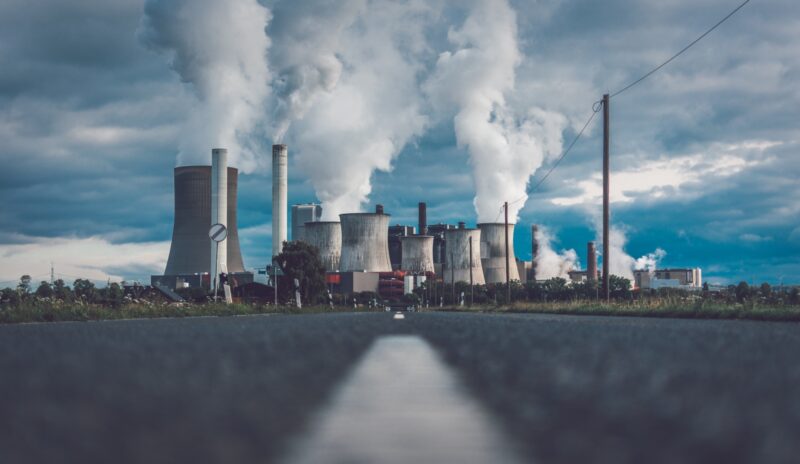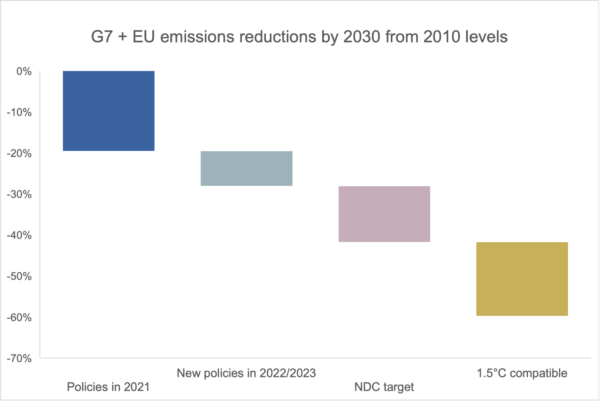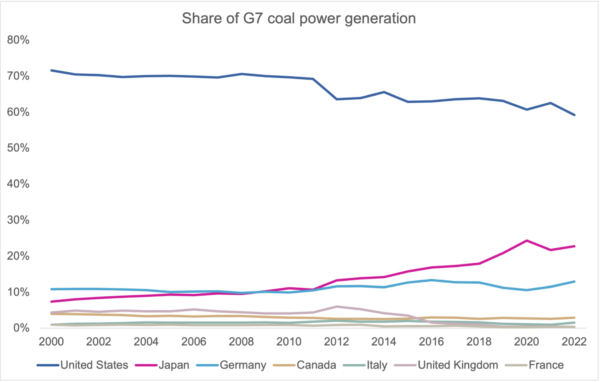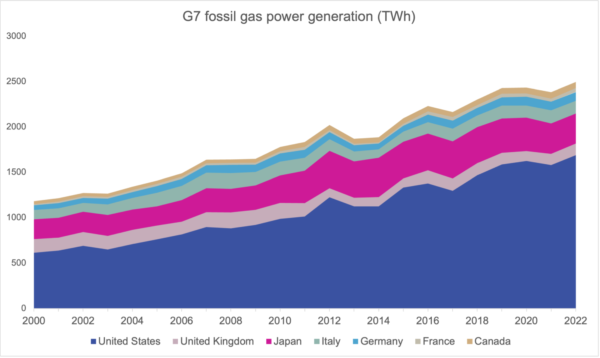G7 moving faster on climate since last Summit, but behind schedule on ending coal and gas
As world leaders gather at the G7 Summit in Hiroshima this weekend, we take a look at progress made since the last Summit on cutting emissions and decarbonising power to see if they’re living up to their promises.
Share

The good news is that the picture looks better than a year ago. Our analysis of data from the Climate Action Tracker finds that current policies of G7 members, including those of the EU, will lower emissions by 22% – 34% below 2010 levels by 2030. This represents an improvement on last year’s projected range of 16% – 23%, but is still not enough to meet their national targets (NDCs). It also falls far short of the 60% collective reduction needed for the G7 to be 1.5°C aligned.
The gap that remains is caused by governments not accelerating their energy transition quickly enough. G7 members continue to invest in fossil fuel infrastructure, and Japan stands out among the group of rich nations as having made very little progress over the last year.
The Climate Action Tracker’s most optimistic projection of Japan’s emissions in 2030 has fallen by just 2% since its 2021 assessment. Although the Japanese Government recently adopted a decarbonisation strategy, it wrongly pursues continued fossil fuel use as a means to ensure growth and energy security. In reality, renewables offer both in spades.
The progress that we have seen over the last year was driven largely by policy changes in the US. The country is set to reduce its emissions a further 10% – 23% by 2030 compared to projections made the year before – mostly thanks to the Inflation Reduction Act (IRA).
Other positive shifts are happening elsewhere. For example, Canada is finally showing progress thanks to clean fuel regulations and mandatory carbon pricing. Nonetheless, among the G7 Canada has the biggest gap to close between its current policies and being 1.5°C aligned.
The EU has also strengthened its climate policies, including its REPowerEU plan, which proposes higher renewable energy and energy efficiency targets. On top of this, the EU’s emergency regulation on permitting seeks to enable faster deployment of renewables, heat pumps and energy grids.
Coal and gas in G7 electricity supply
Last month, G7 climate and energy ministers agreed to take steps towards a phase-out of unabated coal power, yet fell short of naming a deadline. To keep 1.5 in reach, our analysis has shown developed countries need to phase out coal-fired power generation by 2030 and gas power by 2035.
Coal use in the G7 is declining – since 2015, all G7 members aside from Japan have reduced coal power generation by 30% or more. The UK leads with a 93% drop between 2015 – 2022. However, three G7 members still haven’t committed to phase out coal power by 2030 – the US, Germany and Japan.
Japan has only reduced its coal power generation by 6% since 2015. As a result, Japan’s coal use now makes up over 20% of the G7 total – second only to the US. Instead of naming a deadline, Japan is attempting to extend the life of coal in its power sector by promoting carbon capture and storage and ammonia co-firing. This is at odds with what’s needed to reach net zero in line with the Paris agreement.
Share of G7 coal power generation by member countries. Source: Ember global electricity data
Meanwhile, no G7 member has set a gas phase-out deadline. The group’s collective use of gas in the power sector has risen by 19% since 2015. The US, which makes up 68% the G7’s total gas power use, has seen a 27% rise over the same period. The expansion of gas use needs to stop and reverse immediately if the group is to decarbonise its power sector by 2035.
Later this year, in an effort to spur climate action by governments, the UN Secretary General is convening the Climate Ambition Summit. The hope is that this will build much needed momentum in the lead up to COP28, where a global stocktake of action under the Paris Agreement will take place.
As climate impacts intensify and global pressure to act builds, an act of leadership and solidarity from the G7 would set the scene at this critical moment for international cooperation on climate change.
This would mean committing to cut emissions by 60%, phasing out coal power by 2030 and gas power by 2035, and rapidly scale up both renewables and climate finance. The G7 have shown they can accelerate climate action in just one year. Now is their time to demonstrate global leadership, close the final ambition gap, and show to the world a safer, more liveable world is still in reach.














